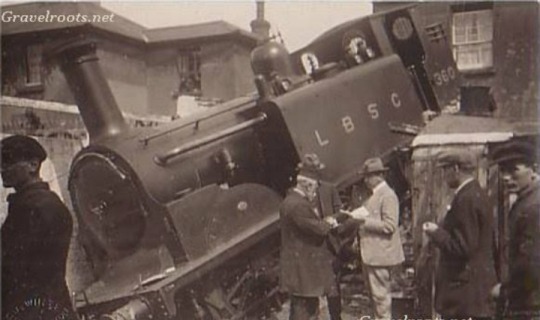Text
No-Where journal No. 9 - 18th September 1922
Page 16: Our new passenger loco
"The NWR board has the pleasure to announce that, thanks to the generosity of Lord Faringdon & the rest of the Great Central Rly Co. That the North Western has become home to two of the GCR locomotives, '9Q' 4-6-0 No. 462 & '9N' 4-6-2T No. 447. This comes almost a year after the arrival of No. 3, the prototype 4-6-2 locomotive that was purchased last which has proven unsatisfactory on the 'Wild Nor' Wester'. The board expresses hope that, despite high coal consumption, No. 462 will prove a better loco on these duties until another locomotive can be procured. The locomotive, built only last year, has already proven it's on the flat between Vicarstown & Marron, but, like most engines of a similar size, require banking up the incline from the Wellsworth side. Lord Regaby has insisted that this locomotive become the railway's new flagship, with it have received the NWR's blue livery within only a week on the railway! And has even commissioned for this locomotive to be named 'Queen Victoria' in order to provide some elegance to the express. Hopefully, this 'Black Pig', as the GC men have started referring to this class as, will prove that even pigs can more than sluggish!."
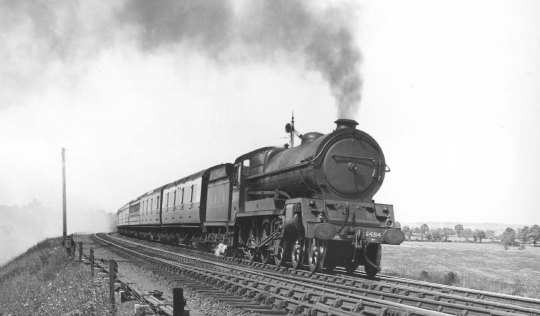
No. 462 "Queen Victoria" seen near Crosby with the 10:00am limited from Tidmouth Central - photo credit: W. Middleton
#The Sudrian Chronicles#98462#ttte#TSC lore dump#No-Where Journal#I'm back!#RWS#the railway series#RWS au
2 notes
·
View notes
Text
Bulleid's Proposed Locomotives
So it turns out Bulleid had so many of his designs dropped for one reason or another, and since I can't stick with a single project for more than a few seconds, I wrote up histories for all of them!
Enjoy the ramblings of a madman who spent a good long while finding free number slots for them.
Southern Railway Warship Class
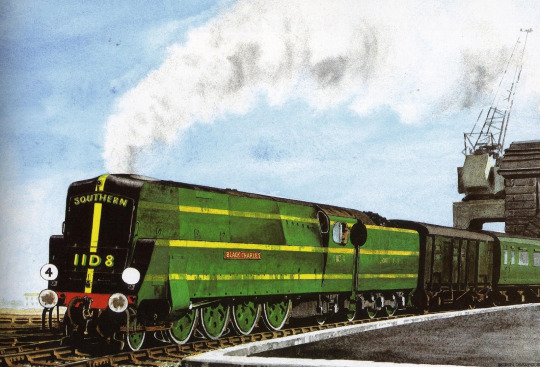
The Southern Railway was the most financially successful of the "Big Four", but this was largely based on investment in suburban and main line electrification. After the successful introduction of the SR Schools class in 1930, the railway had lagged behind the others in terms of modernizing its aging fleet of steam locomotives, as they were more focused on Electrification. Following the retirement of the general manager of the Southern Railway Sir Herbert Walker and Richard Maunsell the Chief Mechanical Engineer (CME) in 1937, their successors considered that the time had come to change this situation. In March 1938 the new general manager Gilbert Szlumper authorized Oliver Bulleid, Maunsell's replacement, to prepare designs for twenty express passenger locomotives. The deteriorating international situation prior to the Second World War was an additional factor in this decision.
Originally, Bulleid had wanted a 4-8-2 Mountain Type, but the Civil Engineering department had resisted this based on size and weight, so a 2-8-2 was chosen instead. Bulleid had worked with Gresley on his P2 2-8-2 express engines, so he already had some background knowledge, especially with the P2’s problems and ideas on how to solve them. Of course, due to the war, they were classified as heavy mixed-traffic engines to get around wartime regulations.
They were built with high-pressure 280 PSI boilers and three 18inx26in cylinders, as well as being the first engines to use Bulleid’s chain-driven valve gear, though the middle cylinder had to be inclined steeply to clear the first driven axle. The boiler was partly welded to save on cost, and the inner firebox was made of steel. The Southern had no facilities to build these boilers, so it was subcontracted to the North British Locomotive Co., as well as Beyer Peacock. They were also fitted with Bulleid’s Air-Smooth Casing. Unlike later designs that utilized this, the casing on the Warships both served their function purpose as labor saving as well as being able to be passed off as some sort of streamlining. How Bulleid got that one through during the war is a mystery! The Warship’s were also the first to use Bulleid’s Firth-Brown Wheels.
10 of these engines were constructed in 1940. More were set to be produced, but once again, the Civil Engineering Department expressed their discomfort at such a large engine running at high speeds with only a single pony-truck in front, despite other engines of a similar design getting on fine elsewhere. This would lead Bulleid to designing and building 30 of his well-known Merchant Navy Class 4-6-2s.
They were named after Warships as a way to increase morale, with 11D1 being officially named “Dreadnought” in April 1940. They performed well in service, hauling heavy passenger and express goods, though the Chain-Driven valve gear was sensitive and required high maintenance, as well as the oil-bath having leaking problems, contributing to wheel-slips(Though the extra wheel helped negate this as well). The casing, while it did save on labor during cleaning, and the more streamlined appearance helped with publicity, it made maintenance hard to carry out. Surprisingly, thanks to their different front ends, they never really experienced drifting smoke like Bulleid’s Pacifics.
All 10 of the engines would be passed into British Railways, numbered 37001-37010, where their duties mostly stayed the same. 11D8 “Black Charles'' took part in the 1948 locomotive exchange trials, where it was compared to LMS Duchess pacifics and LNER A4’s and A2/2s, where it performed favorably, though the chain driven valve gear and its oil bath still caused headaches. After the Crewkerne incident, BR chose a rebuilding program of any engines that still used Bulleid’s Chain Driven motion, however, as the Warships had required far less modifications that the Pacifics, they were on the bottom of the list in the rebuilding program. In the end, only 37003 “Triumph”, 37009 “Warspite”, and 37010 “Exeter” were rebuilt in 1956, 1957, and 1959.
Despite their status as a class with very few engines, all ten would survive until the end of southern steam, going between 1965-1966.
Two are preserved, both being rescued from Barry Scrapyard in Wales. These examples are Class Pioneer 11D1 “Dreadnought”, as well as 11D3 “Triumph”.
Stats
Power Classification - 8MT
Built - 1940 to 1941
Boiler Pressure - 280 PSI
Cylinders (3) - 18in x 26in
Wheels (Driven) - 6ft 2in
Wheels (Leading) - 3ft 1in
Wheels (Trailing) - 3ft 7in
Wheels (Tender) 3ft 7in
Tractive Effort - 40,640 lbf
Total Length - 74ft 8in
Fleet
11D1 (37001) - Dreadnought
11D2 (37002) - Anson
11D3 (37003) - Triumph
11D4 (37004) - Vanguard
11D5 (37005) - Ark Royal
11D6 (37006) - Audacity
11D7 (37007) - Valiant
11D8 (37008) - Black Charles
11D9 (37009) - Warspite
11D10 (37010) - Exeter
Southern Railway Prototype Light Pacific
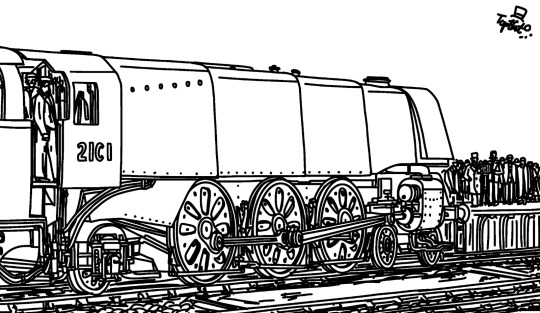
(Pic by Sttophat on twitter)
In 1941, Bulleid had introduced his Warship Mikado's and Merchant Navy Pacific's to become the main motive power for the Southern Railway’s Express passenger trains, though while they performed well, they were restricted by their weight, especially since the condition of the rails were hampered by the Second World War. Initially, trains on the lighter sections were handled by the Q1 0-6-0 freight engines and other, older engines, but they couldn’t handle the faster trains that were anticipated after the war. There was also the planned electrification of certain areas after the war, so the new design also needed to handle freight traffic as well, fast enough to not impede electric services.
What was decided on in the end was a downsized version of the Merchant Navy’s, fitted with the same design theory of the Q1’s to create a “Light Pacific”. The Locomotive was completed in 1942 alongside the Q1’s, and was trialed for a short time before entering service. It was deemed a success, and numbered 21C201. It was powerful enough to handle fast, heavy trains, as well as having an extremely light axle loading for a pacific at 16.5 Tons, enabling it to be used on almost every part of the UK Network as a whole. However, Bulleid decided to go with a different approach, creating simply a downsized Merchant Navy with no Q1 elements. This would increase the axle load, though this wasn’t much of an issue, as the Battle of Britain and West Country Class Light Pacifics still had a high enough route availability for the work they were assigned. Thus, the “Q1 Light Pacific'' would remain a one-off.
During the war, No.21C201 would actually travel a fair amount, and would regularly venture out of Southern territory, its light axle-load coming in handy. After the war however, it would mostly stay in the South. Performance-wise, it seemed to inherit all of the good qualities from the Q1’s and the pacific’s. The light-weight was already a plus, coupled with a great, free-steaming boiler and additions that made the driver and fireman’s life easier. However, it also inherited the bad aspects as well. The chain-driven valve gear was a well-known headache on bulleid locomotives, but there was also the issue that its light-weight caused. The regular Light Pacifics had trouble starting heavy trains thanks to their weight, but No.21C201 had it worse, especially with the well-known issues with the oil bath the valve gear was situated in. The light weight would also affect braking power as well, making unfitted trains harder to stop, a trait inherited from the Q1’s.
No.21C201 (Now Renumbered 34000) was not considered for rebuilding like the other Bulleid Pacifics due to its one-off status. It would be given a general repair in 1960 before spending the rest of its life at Nine-Elms, mainly working express and semi-fast goods trains and the occasional passenger turn during peak period and summer excursions. It was withdrawn from service in 1966 and broken up at Eastleigh.
Stats
Power Classification - 6MT
Built - 1942
Wheels (Driven) - 6ft 2in
Wheels (Leading) 3ft 1in
Wheels (Trailing) - 3ft 7in
Wheels (Tender) - 3ft 7in
Boiler Pressure - 250 psi
Cylinders (3) - 16.5in x 24in
Tractive Effort - 28,145lbf
Total Built - 1
Southern Railway L1 Class
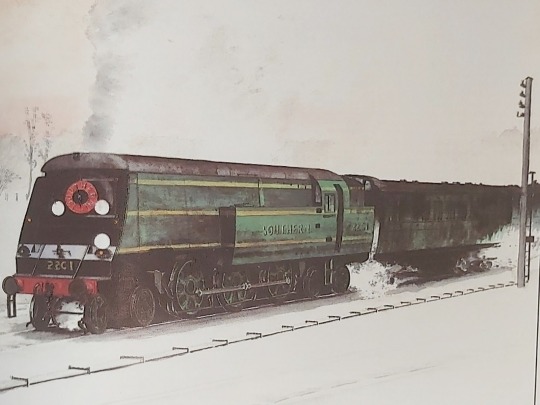
Bulleid designed these locomotives during the Second World War, but construction didn’t begin until 1946. They shared many components with Bulleid’s Q1 0-6-0 goods engines, and were essentially the Q1’s with an Air-Smoothed Casing and a bigger boiler (though the firebox was identical with that of a Q1’s).
Twelve of these engines would be constructed between 1946 and 1948, with the final 3 being built by British Railways. They were originally numbered 22C1 to 22C12, though they were renumbered in 1949 to 36101 to 36112. They were originally meant for short distance goods and passenger services, though they never really found their footing in this role. The passenger trains that usually necessitated big tank engines were already being handled by electric engines, and everything else usually required smaller and lighter engines, which meant that, despite inheriting the power and efficiency of the Q1, the added weight and size meant that they were barred from where they could be most effective. The goods work they were meant for were also in the care of both Q1’s and Maunsell’s Q Class, as well as the many N class moguls already in service. In the end they spent their time hopping from shed-to-shed before settling on ex-LSWR territory, and even venturing into Western Region territory.
They were withdrawn between 1962-1964. Only one survives, 22C9 (36109) on the Bluebell Railway.
Stats
Power Classification - 5F 4P
Built - 1946 to 1948
Boiler Pressure - 230 PSI
Cylinders (2) - 19in x 26in
Wheels (Driven) - 5ft 1in
Wheels (Bogies) - 3ft 1in
Tractive Effort - 30,080 lbf
Southern Railway Dock Class
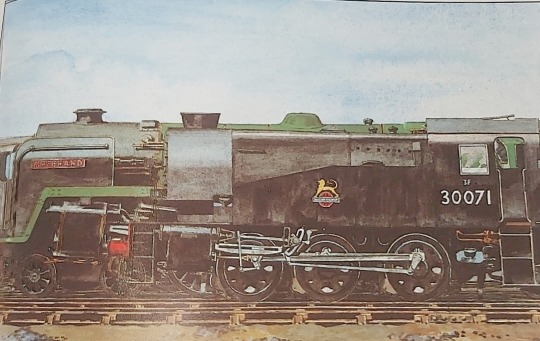
After the Second World War, many of the Southern Railway’s shunters (mainly those at Southampton) inherited from pre-grouping companies were worn out and needed overhauling. As such, Bulleid opted to replace them outright with his own design of 0-6-0T, with a short wheelbase of 10 feet to enable it to negotiate the tight curves. Like many of Bulleid’s designs, he equipped it with a relatively high boiler pressure.
Six would enter service in 1946, and while a total of 18 were planned, this would never come to be, as Eastleigh works was not in a position to build new locomotives with the backlog from the war. In the end, the southern found it cheaper to purchase ex-USATC S100 dock shunters, as they fulfilled most of the requirements needed.
They were numbered C201 to C206, and were renumbered to 30071 to 30076 in British Railways days. The first, 30071, was built with the Idaglass boiler lagging and casing as used in the Q1 class, while the other 5 were built with conventional boiler lagging and tanks. 30071 would be rebuilt like the others in 1953.
The class would lead uninteresting lives as dock shunters in Southampton and Dover until their withdrawal between 1961-1962. One was initially purchased for preservation but the deal fell through. None are preserved.
Stats
Power Classification - 3F
Built - 1946
Boiler Pressure - 220 PSI
Cylinders (2) - 16in x 24in
Wheels (Driven) - 4ft 6in
Tractive Effort - 21,276 lbf
47 notes
·
View notes
Text
A Thomas Headcanon
I have a lot of theories and headcanons about Thomas The Tank Engine, and this is just the most recent one I’ve had. While reading Thomas & The Guard again - as you do - I happened to spot this little detail on the opening page:
[Thomas] has two coaches. They are old, and need new paint, but he loves them very much. He calls them Annie and Clarabel. Annie can only take passengers, but Clarabel can take passengers, luggage and the Guard.
And it was that sentence in bold which really caught my attention. Not only does it imply that Annie & Clarabel were not named as such until Thomas received them, but it also suggests that Thomas himself named them. (In the original books, anyway. The TV series implies that they were named long before they met Thomas, and this is all but confirmed in The Adventure Begins.)
But where would Thomas have gotten those names from? Well, to answer that, we just have to look at Thomas’ entry in the Engines section of The Island of Sodor:
A Billinton E2 0-6-0 tank from the London Brighton & South Coast Railway which arrived on Sodor in 1915, no-one quite knows how! His crew got on well with the local people, both married Sodor girls, and by 1920 neither wanted to be parted from their engine or leave the Island.
Again, it’s the bit in bold that’s of interest to us. Now, we don’t officially know the names of the women Thomas’ crew married (or those of Thomas’ crew, for that matter), so this is what I’m thinking: Perhaps their wives happened to also be called Annie and Clarabel, and so when Thomas received his coaches, and wanted to give them names, he thought, what better names to give them than those of his crew’s wives?
A bit of a stretch, yes, but it’s a sweet idea nonetheless.
32 notes
·
View notes
Text
Thinking about my OCs, Stanley and Monty. They are so neat. :3
2 notes
·
View notes
Text
Me: *Sees B4 Edward in the top right*
Me: *Happy B4 Edward fan sounds*


Presenting the LBSCR B4! Including @mean-scarlet-deceiver's OC Linda!
32 notes
·
View notes
Text

Purchased in 1921, the NWR 's No.2 was an Atlantic of obscure origins. Sold second or third hand the the NWR by the Furness Railway, It had been sold for a bargain as the engine was reported to be a poor steamer. Originally believing they had screwed over the NWR, the Furness were soon regretting their decision too sell the engine as Crovan's Gate has easily rectified the engines steaming issues, resulting in a reliable free steaming locomotive. The engine was named after the wife of one of the directors, Alice Edwards.
40 notes
·
View notes
Text

fucking spit on his ass, veronica
spit the bastard out
51 notes
·
View notes
Text
Could it BE?
Is it TRUE?
Do I actually have a release date for Issue 1 of Beyond?
YES.

40 notes
·
View notes
Text
One November 1929, one to go please!

Chose your new mikado boyfriend (or girlfriend)!!!
Tank engine edition!!!
48 notes
·
View notes
Text
Most of these selections come straight from the nominations I solicited on my blog. I did throw in two more options of my own choosing.
If you haven't read the books please refrain from voting or we'll send one of the Controllers after ya.
21 notes
·
View notes
Text
If the Class 60 were considered 'Grand Engines' by ANYONE other than Ex-caley management then the 956 Class must have been the best things ever built
Ayr shed was in a spot of bother just then... I heard that increased power was to be provided for this train, and waited in pleased anticipation of a Class 5X or a Baby Scot. On 18 January 1937 there arrived at Ayr for the 7.46am Caledonian class 60 4-6-0 No 14641! I am not exaggerating when I say that of all classes of engine employed on main line express work at that time, none had a poorer reputation than the Caley 60s. My own runs behind them had been dull in the extreme. I knew an LMS official (ex-Caley) who commuted by the 7.46am, and in conversation I ventured to hint that the authorities might have done something better for that train. He was shocked. 'Oh, but these are grand engines!' he protested... [14641] did not remain at Ayr very long.
- David Smith, Legends of the Glasgow & South Western Railway (in LMS Days)
24 notes
·
View notes

